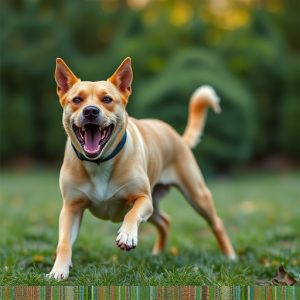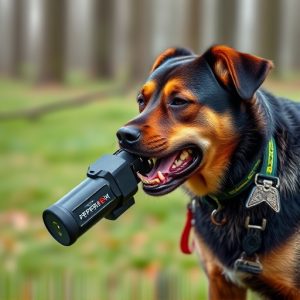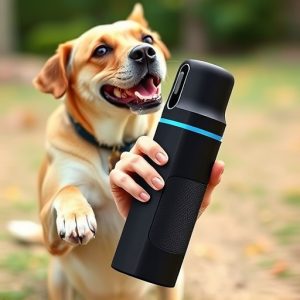Mace for Dog Attacks: Range, Science, & Legal Considerations
Dog attacks pose life-threatening risks, emphasizing the need for individuals to comprehend key dyna…….
Dog attacks pose life-threatening risks, emphasizing the need for individuals to comprehend key dynamics. Animal pepper spray is a crucial non-lethal defense option with an effective range of 3-10 feet (1-3 meters), temporarily disorienting dogs by irritating their eyes, nose, and throat. Understanding risk factors like breed, size, temperament, situation, and environment, along with the spray's range, allows for strategic positioning and consistent application techniques. Regular practice builds confidence in swift, effective responses during actual encounters.
In the face of potential dog attacks, understanding effective defense strategies is paramount. This comprehensive guide explores the role of mace as a powerful tool for personal protection against aggressive canines. We delve into the science behind animal pepper spray, comparing it to traditional options, and analyze its active ingredients for optimal efficacy. Learn about the dynamic factors influencing dog attack risks and discover key application techniques within the effective range for maximum safety.
- Understanding Dog Attack Dynamics: Factors and Risks
- Traditional vs. Animal Pepper Spray: A Comparative Analysis
- The Science Behind Mace: Active Ingredients and Efficacy
- Effective Range and Application Techniques for Optimal Protection
- Legal Considerations and Responsible Use of Pepper Spray for Dog Defense
Understanding Dog Attack Dynamics: Factors and Risks
Dog attacks can be unpredictable and life-threatening, making it crucial for individuals to understand the dynamics at play. Several factors contribute to the risk of a dog attack, and recognizing these can help in preventing or mitigating such incidents. One key aspect is the effective range of animal pepper spray, which serves as a non-lethal defense option against aggressive dogs. Unlike conventional weapons, it doesn’t cause permanent harm but disrupts the dog’s senses, providing an escape opportunity for the victim.
Other risks include the dog’s breed, size, and temperament, as well as the situation or environment in which the encounter takes place. For instance, a trigger-happy dog in a confined space may pose a greater threat than one relaxing in its owner’s backyard. Understanding these dynamics is essential for individuals to equip themselves with appropriate tools like animal pepper spray, ensuring their safety during potential dog attack scenarios within their effective range.
Traditional vs. Animal Pepper Spray: A Comparative Analysis
When it comes to self-defense against dog attacks, traditional pepper spray and animal-specific pepper spray options both have their merits. However, a crucial factor in choosing between them is understanding their effective range. Traditional pepper spray, often used for human confrontations, typically has an effective range of about 4 to 6 meters (13 to 20 feet). This range is sufficient for many situations but might not be adequate when facing an aggressive dog from a distance.
On the other hand, animal pepper spray is designed with dogs’ sensitivities in mind and offers a slightly longer effective range, usually extending up to 7 to 9 meters (23 to 30 feet). This extended reach provides a crucial extra moment for users to create distance or seek assistance during a dog attack. The enhanced range ensures that individuals can defend themselves more effectively, especially when dealing with larger breeds or dogs displaying extreme aggression.
The Science Behind Mace: Active Ingredients and Efficacy
The Science Behind Mace: Active Ingredients and Efficacy
Mace, a type of animal pepper spray, is an effective defense mechanism against dog attacks. Its active ingredients are capsaicin, the compound responsible for the hot and burning sensation in chili peppers, and various stabilizers to ensure potency. When deployed, mace creates an effective range that can deter aggressive dogs, providing users with crucial seconds to escape or seek help.
The spray’s efficacy stems from its ability to irritate the dog’s eyes, nose, and throat, temporarily disorienting them. This disruption in their sensory perception allows the user to retreat safely. Research indicates that when used correctly, animal pepper spray can be 95% effective in deterring attacks, making it a valuable tool for individuals facing dangerous canine encounters.
Effective Range and Application Techniques for Optimal Protection
The effective range of animal pepper spray, often referred to as mace, is a critical factor in ensuring optimal protection against dog attacks. It’s crucial to understand that this range varies among different brands and types of spray, but typically ranges from 3 to 10 feet (or roughly 1-3 meters). Knowing your spray’s specific reach allows you to position yourself strategically for maximum impact and safety. For instance, aim slightly above the dog’s eyes, as pepper spray is most effective when it reaches sensitive areas like the face and respiratory system.
Application techniques play an equally vital role in its effectiveness. A swift, direct spray into the dog’s face at close range (within the stated effective range) is ideal. Aim for a cloud of spray that covers both eyes and nostrils to disrupt balance and breathing temporarily. Remember, consistency is key; follow up with additional bursts if needed, staying within the spray’s reach. Practice these techniques regularly in controlled environments to build confidence and ensure a swift, effective response during actual encounters.
Legal Considerations and Responsible Use of Pepper Spray for Dog Defense
In conclusion, understanding dog attack dynamics and armed with knowledge about effective range and application techniques, animal pepper spray emerges as a viable defense option. Its unique properties and proven efficacy make it a responsible choice for those at risk of dog attacks. When used correctly, pepper spray can provide crucial time to escape dangerous situations, emphasizing the importance of legal considerations and safe handling practices. By staying informed and prepared, individuals can better navigate potential risks and enhance their safety in areas frequented by dogs.


